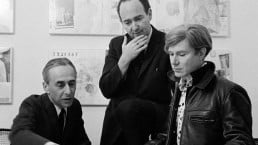
The history of art dealing can be said to date back to the Italian Renaissance, when Giovanni Battista della Palla sold works by the greatest artists of his day to the king of France. Since those golden days of art, the art world has continued to develop into a fascinating and complex organism in which art dealers play an essential role.
Art dealers are, first and foremost, art lovers and art connoisseurs. They also have to be exceptionally adept at the business aspect behind art. Mostly, art dealers have their own galleries and buy or consign works from artists or auction houses, then sell the works to interested collectors. They also work on consignment, selling art works on behalf of the original owner, making their money from a commission in the event of a sale. Galleries are at the vanguard when new art emerges: taking the risks, paying the bills and creating the infrastructure and ecosystem to support the artists. Museums, art institutions and non-profit organisations invariably identify new trends and movements by paying attention to gallery activities, and often seek out the advice of art dealers when they want to borrow artworks for their exhibitions or acquire them for permanent collections. Art dealers are always tuned in to what is new, exciting and of value in the art market. They have to be up-to-date with the rapidly changing trends and tastes dominating the art world, while at the same time being aware of who will always remain the best-selling artists, no matter how much time goes by.
This article will provide you with a concise history of art dealing by zooming in on some of the key players throughout the centuries who have shaped how the industry has evolved. Some of these art dealers gave the very first vote of confidence to avant-garde artists who were not yet widely recognised and would go on to become some of the most influential and groundbreaking artists in the history of art.
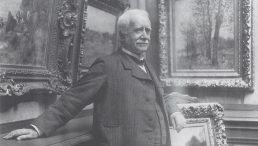
Paul Durand-Ruel
“I come to my great crime, the one that overshadows all the others. For a long time I have been purchasing and praising to the sky works by some highly original and highly knowledgeable painters, several of whom are geniuses, and I intend to have art lovers accept them.” – Paul Durand-Ruel referring to the Impressionists in 1885
Paul Durand-Ruel championed the painters of the Barbizon school in France, and later brought attention to the Impressionists. Their notoriety owes a great deal to the recognition they received from this man. Born in 1831 into a family of art dealers, Durand-Ruel’s father owned a gallery at 103 rue des Petits Champs, where he began specialising to become an art dealer. When his father died Durand-Ruel inherited the gallery and started working in what was an innovative fashion for that time, organising individual exhibitions, the promotion of art, and creating an international network of galleries. He became the first modern art dealer to support his artists with monthly stipends and solo exhibitions. Moreover, he made connections with an international group of collectors and galleries in Paris, London and New York.
Since the early 1870s, he started supporting the controversial group of artists who came to be known as the Impressionists, inventing new methods for the promotion and dissemination of their work. He had met Claude Monet and Camille Pisarro during their stay in London at the time of the Franco-Prussian war, and became fascinated by their works and those of fellow Impressionists Édouard Manet, Edgar Dégas, Alfred Sisley, Paul Cézanne, Berthe Morisot and Pierre-Auguste Renoir. At one point, Durand-Ruel bought 23 paintings from Manet for 35,000 francs. His purchases provided the group of artists with a huge boost, and proved that these artists did not have to be accepted by the official Salon in order to be appreciated and sell art. In 1876, Durand-Ruel hosted an exhibition of Impressionism in his own gallery, and both the exhibition and his gallery were called insane by the public and other art professionals. Between 1876 and 1886, Durand-Ruel remained one of the only people supporting the Impressionists, and he continued to purchase their paintings and promote their art. In 1883, he organised shows for them in Berlin, London, Boston and Rotterdam, but these were not received particularly well. However, in 1886, he organised an exhibition of Impressionism in New York, which turned out to be a major success. This marked a breakthrough for Impressionism, as it became more and more popular in America and Impressionist art started to be added to important collections.
Throughout his lifetime, Durand-Ruel spent millions of francs on Impressionist art, collecting approximately 12,000 paintings including about 1000 Monets, 1500 Renoirs, 800 Pisarros and 400 each by Degas and Sisley.
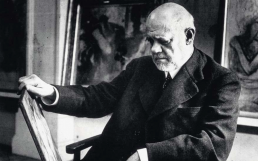
Ambroise Vollard
“Have you heard how vast his legacy is, finds are being made everywhere, valuable items are scattered around, none of them displayed or recorded, priceless things are being found under stacks of canvases.” – artist Jacques-Emile Blanche referring to the collection of Ambroise Vollard after his death
Ambroise Vollard was born in the French colony La Réunion in 1866, and studied law in Montpellier and Paris. He soon abandoned his lawyerly ambitions and started making ends meet by selling prints and drawings he had bought from the stands lining the quays of the Seine. Vollard had an excellent eye and a good sense for business, proven by the fact that he bought a group of unfinished drawings and paintings by Édouard Manet from Manet’s widow. He exhibited these works in 1894 to great acclaim, and was then introduced to Edgar Degas, Berthe Morisot, Pierre-Auguste Renoir and Paul Cézanne, with whom he soon formed close ties and friendships. Vollard bought hundreds of paintings by Renoir and encouraged him to try sculpting. Vollard also spent a great deal of effort in support of the Post-Impressionists – he recognised Vincent van Gogh’s talent, organising exhibitions that kept Van Gogh in the public eye after his death. He also organised the first major exhibition of works by Paul Gauguin, and eagerly promoted the Nabi artists in the late 19th century, collecting works by Odilon Redon, Pierre Bonnard, and Édouard Vuillard.
But Vollard is perhaps best known for his keen eye for the future of art – he was one of the best scouts of new talent, and soon recognised and started supporting a new generation of artists including none other than Pablo Picasso. In fact, Vollard gave Picasso his very first Paris show in 1901. In 1904, he organised the first solo shows for Henri Matisse and Kees van Dongen. He also supported Georges Braque, André Derain, Juan Gris, and Fernand Léger. All of this cemented Vollard’s position as one of the most important voices in the art world at the time. His gallery became a centre for avant-garde art in Paris, attracting important collectors ranging from Gertrude and Leo Stein to the King of Serbia. He also allowed artists to trade works there – Picasso exchanged his own works for pieces by Degas and Matisse, Degas and Renoir fought over a work by Cézanne, and Matisse pawned his wife’s emerald ring for Cézanne’s Three Bathers. When the First World War broke out, Vollard was forced to close his gallery and continued running a private dealership out of his apartment.
His vast artistic estate was divided between his brother and an alleged mistress when he died, and most of the pieces, which had become dispersed during the Second World War, turned up again after the war in places as random as the New York art market, a farmhouse in a Serbian village, and a Paris bank – Vollard’s protégé, the Serbian Erich Šlomović, had stashed hundreds of his works during the war for safe-keeping. Vollard remains known for buying up large chunks of artists’ inventories and reselling these at a large profit, which didn’t always make him the most beloved person in the art world, but his excellent eye and vast knowledge of art are unquestionable.
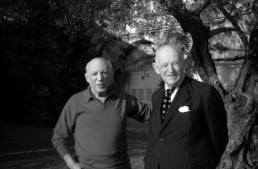
Daniel-Henry Kahnweiler
“Representation and structure conflict. Their reconciliation by the new painting, and the stages along the road to this goal, are the subject of this work.” – Daniel-Henry Kahnweiler on Cubism in “The Rise of Cubism”
Daniel-Henry Kahnweiler was the pioneering champion of Cubism. He opened his first gallery, Galerie Kahnweiler, in Paris in 1907. Not only critics and collectors, but also the artists he dealt with revered him, and he was a respected art historian. Kahnweiler mainly presented works in his collection on a rotating basis, showing pieces by Braque, André Derain, Picasso, Maurice de Vlaminck, among other artists. He was the first art dealer to sign exclusive contracts with artists like Georges Braque, Pablo Picasso, Juan Gris, Fernand Léger, and André Derain, and was one of the earliest theorists of their work. The contracts he had with these artists made him the sole supplier of Cubist art before the First World War. Kahnweiler is known for being a real connoisseur – he is one of the first people who recognised Picasso’s Les Demoiselles d’Avignon for the masterpiece it was, and supposedly offered to buy it on the spot. Leo and Gertrude Stein, along with a whole host of other important collectors of the time, were Kahnweiler’s clients, and Kahnweiler also established connections with many international art dealers including Alfred Stieglitz in New York.
When the First World War broke out, Kahnweiler, a German national, was declared an enemy alien in France and was exiled. His gallery and art collection were confiscated and sold at auction – 1219 works by Braque, Gris, Léger and Picasso were among the works sold. Kahnweiler lived in Switzerland in this period, where he started working as an art critic, and published important texts like The Rise Of Cubism (1920), which is considered a seminal text for the theory of Cubism, as well as a catalyst for Picasso’s international acclaim. Kahnweiler was able to return to Paris in 1920, where he opened a new gallery, Galerie Simon. War complicated things again when the Second World War broke out and his stepdaughter Louise Leiris had to buy Galerie Simon in order to prevent the gallery from closing down, since Kahnweiler was Jewish. Until his death in 1979, Kahnweiler and Leiris worked together closely at the gallery, which had become Galerie Louise Leiris.
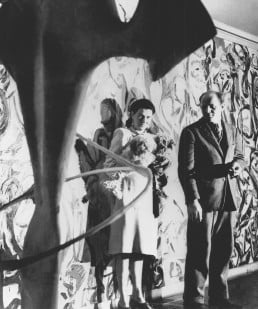
Peggy Guggenheim and The Art of This Century Gallery
“I took advice from none but the best. I listened, how I listened! That’s how I finally became my own expert.” – Peggy Guggenheim
In 1942, legendary heiress and art patron Peggy Guggenheim opened the Art of this Century gallery in New York. Born in 1898 into an immigrant family from Switzerland who had made their fortune in the mining industry, Guggenheim became part of the New York social scene at an early age and was known for defying the conventions of her time. She moved to Paris in the ‘20s, became friends with artists including Marcel Duchamp and Man Ray, and married artist Laurence Vail, with whom she had two children. Guggenheim opened her first gallery in London in 1938, where she showed art by Jean Cocteau, Vasily Kandinsky, Henri Laurens, Jean Arp, Max Ernst, and Pablo Picasso. The gallery put in a loss during its first year and closed. While she was planning the opening of a London museum, the Second World War broke out and Guggenheim, of Jewish descent, had to flee Europe when the Nazis invaded Paris. She also helped André Breton, his wife and Max Ernst, whom she was later to marry, obtain refuge in the United States.
Back in New York, Guggenheim focused on a new gallery project: the Art of this Century gallery, which opened on October 20th 1942 and was the art world event of the season. This was the first major gallery in New York that provided a space for European war émigrés and emerging New York artists, who were able to coalesce and exchange there.
In 1943, she organised the seminal show Exhibition by 31 Women. It was a real boundary-breaking show with which Guggenheim placed some of the most important female artists of the 20th century in the context of the mostly male-dominated art world and in particular the Surrealist movement. Featured artists included Frida Kahlo, Alice Trumbull Mason, Gypsy Rose Lee, Hedda Sterne and Dorothea Tanning. Max Ernst ended up leaving Guggenheim for Tanning after they met in connection to this exhibition.
After this show, Guggenheim started focusing more and more on Abstract Expressionism. Art of this Century played a very large role in the launching of the careers of many Abstract Expressionists – Lee Krasner, Jackson Pollock, Mark Rothko, Adolph Gottlieb, Ad Reinhardt, Hans Hofmann, Clyfford Still and Willem de Kooning were all exhibited here. In fact, Guggenheim discovered Pollock after Piet Mondrian had pointed her in his direction and she gave him his very first solo exhibition. Soon enough, Guggenheim started paying Pollock an annual stipend which allowed Pollock and his wife Lee Krasner to buy their home and studio on Long Island.
Art of this Century was divided into four distinct spaces: the Abstract Gallery, the Surrealist Gallery, the Kinetic Gallery (which showed the permanent private collection which Peggy Guggenheim had collected in Europe), and the Daylight Gallery (a commercial gallery for temporary exhibitions). It was very common for Guggenheim to purchase works from artists who had exhibitions in her gallery, therefore making a show in her gallery a great opportunity for artists. The combination of it being a private collection and a public gallery made the space completely unique. Art of this Century put on 50 exhibitions and featured 103 artists between 1942 and 1947, after which Guggenheim relocated to Venice and continued her legacy to the art world there until her death. Nevertheless, in this very short lifespan, Art of this Century made one of the most profound and long-lasting impacts on the New York art world, and the art world at large.
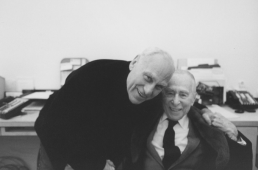
Leo Castelli
“That son-of-a-bitch, give him two beer cans and he could sell them.” – Willem de Kooning on Leo Castelli
Leo Castelli became one of the most influential art dealers in the New York art scene in the ‘60s, when he started pushing for a move beyond Abstract Expressionism and representing artists and styles that were to become the next big thing. Castelli was always hungry to show the most cutting-edge art of the time. His first big impact came when he represented artists in his gallery such as Jasper Johns and Robert Rauschenberg, who, although they came onto the scene at a time when Abstract Expressionism was still the dominant art movement, were clearly moving into totally new and unknown territories.
Castelli opened his Leo Castelli Gallery on the Upper East Side in 1957, when he was already 50 years old. Before that, he had roamed from Trieste to Milan, Bucharest and Paris. In Paris, his wife’s father had backed his first art venture, a gallery on the Place Vendôme, which focused on modern furniture and decoration. But soon enough, Castelli switched focus and started selling Surrealist paintings after a friend had introduced him to the Paris art scene. When World War II broke out, Castelli and his wife fled to New York, where he soon became a part of the New York avant-garde art scene. When he finally opened his Leo Castelli Gallery, it was with the intention to find the newest, most groundbreaking art that would surpass the Abstract Expressionists and prove their work to be outdated. The first shows featuring works by Jasper Johns and Robert Rauschenberg were a success and made a profound impact on the art world. Alfred Barr, who was the director of MoMA at the time, came to Jasper John’s opening at Leo Castelli Gallery, stayed for three hours, and bought four works for the MoMA on the spot. After that, there was no turning back – it was truly the end of the era of Abstract Expressionism. In the following years, Castelli exhibited works by Roy Lichtenstein, Andy Warhol, Donald Judd, Frank Stella, John Chamberlain, Claes Oldenburg, James Rosenquist, Dan Flavin, Bruce Nauman and Richard Serra at his gallery.
Castelli is perhaps best known for devising a new model for dealing with the artists he represented which was so influential it has since become known as the “Leo Castelli Model.” Previously, galleries would sell works and split the profits with the artists. The Leo Castelli Model, however, forged a strong bond between artist and gallery by having the dealer provide for the artists in various ways: they would get money for a studio and art supplies; the dealer would track the artist’s market to ensure prices wouldn’t get too inflated; and the gallery would take care of the artist’s brand, handle public relations and press, and organise regular exhibitions. What’s more, Castelli believed strongly in giving his artists a stipend every month. He continued to pay them a stipend no matter whether they were working at the time, or whether their work was in demand. The cornerstone of the Leo Castelli Model was a mutual, unconditional trust and loyalty between dealer and artist that would allow for a long-term relationship.
Later in his career, Castelli started working with and mentoring a younger generation of art dealers. One of them was Mary Boone, through whom he discovered Julian Schnabel, which led to Castelli and Boone co-representing Schnabel. Castelli even mentored Larry Gagosian in the early stages of his career, before he went on to become the art world giant he is today. Castelli connected Gagosian with artists to show at his Los Angeles galleries in the early ‘80s, as well as with a whole host of collectors who would eventually make it possible for Gagosian to expand his gallery empire to 16 galleries around the world.
Without a doubt, Leo Castelli is one of the main forces responsible for positioning New York at the very centre of the art world.
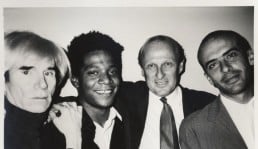
Bruno Bischofberger
“I took them for lunch to be photographed for a portrait. Jean-Michel did not want to stay for lunch… about an hour and something later, he arrived with this huge painting. Andy said to me, ‘Oh, I’m so jealous! He’s faster than me!’” – Bruno Bischofberger on introducing Basquiat and Warhol
Bruno Bischofberger is known especially for having introduced American Pop Art to Europe in the ‘60s, and American Neo-Expressionism in the ‘80s. Born in Zurich in 1940, Bischofberger opened his first gallery in Zurich in 1963. In 1965, he hosted an exhibition of American Pop Art, showing works by Andy Warhol, Roy Lichtenstein, Robert Rauschenberg, Jasper Johns, Tom Wesselman and Claes Oldenburg. He also became the first gallery to show the works of Gerhard Richter outside of Germany. Bischofberger entered into a “first right of refusal” contract with Andy Warhol in 1968, which remained in place until Warhol’s death in 1987. He also introduced Warhol and Basquiat, which led to the two artists’ friendship and collaboration.
Aside from his passion for Pop Art and Neo-Expressionism, he also championed the Nouveau Réalisme movement with artists like Yves Klein and Jean Tinguely and organised a series of one-man exhibitions in the ‘70s of Minimalist and Conceptual artists like Dan Flavin, Donald Judd, On Kawara, Joseph Kosuth, Sol LeWitt and Bruce Naumann. Meanwhile, he made sure to add modern classics like Pablo Picasso, Henri Matisse and Fernand Léger to the gallery programme.
During the ‘80s, when he was mostly showing Neo-Expressionist artists – Jean-Michel Basquiat, Julian Schnabel, David Salle, Francesco Clemente, Enzo Cucchi, George Condo and Jiri Georg Dokoupil – he would fly back and forth between Zurich and New York twice a month to visit artists’ studios and galleries and purchase works for his gallery. He became Basquiat’s Europe art dealer until the artist’s premature death in 1987. In 1997, Bischofberger gave Damien Hirst a one-man show at his gallery.
Bruno Bischofberger continues to be an unstoppable force even today, contributing to the field of art research by publishing books on many of the artists he has worked with through his gallery and organising exhibitions. He has also started focusing on his more recent passion for architecture, and currently represents contemporary architect and designer Ettore Sottsass.
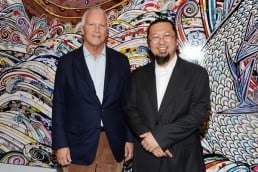
Larry Gagosian
“There wasn’t a plan to get into the art world; I didn’t see this as an entry point. It was not a professional decision — if I’d seen somebody else selling something, I might’ve sold that. I was very lucky that it turned out to be a career path.” – Larry Gagosian
No history of art dealing would be complete without mention of this art world giant. Larry Gagosian is arguably the most influential art dealer of our time, with a whopping 16 galleries to his name spread all around the world. The son of two Armenian émigrés grew up in Los Angeles, and his entrance into the art world actually came when he started selling posters on the street hoping to make some extra cash on the side of his valet job. From selling cheap posters, he made the transition to selling better-quality posters for more money, from which point he transitioned into selling art.
He opened his first gallery for modern and contemporary art in Los Angeles in 1980, where he showed works by artists including Jean-Michel Basquiat, Eric Fischl and David Salle – thanks to Leo Castelli’s mentorship and connections. Five years later, he expanded to New York with a gallery in Chelsea. In 1989, he opened a new gallery on Madison Avenue with a major Jasper Johns exhibition. The gallery also showed works by the likes of Yves Klein, Andy Warhol, Jackson Pollock and Cy Twombly. Gagosian had a close relationship with the latter, and the two worked together for many years. Another artist he has represented for decades is Richard Serra, with whom he started working in 1982. Gagosian also organised the first exhibition of Damien Hirst’s animals in formaldehyde tanks in 1996. The artists he represents in his galleries worldwide fit seamlessly with the following statement he once made: “Something that I’ve always paid attention to is to work with the most important artist that I could.” From the very beginning, Gagosian wanted to show art world heavy-hitters – he knew they would generate the best business. Gagosian represents big names like Georg Baselitz, Ellen Gallagher, Andreas Gursky, Anselm Kiefer, Jeff Koons, Takashi Murakami, Ed Ruscha, Richard Serra, Taryn Simon, Albert Oehlen, Nam June Paik, Rachel Feinstein, John Currin, Helen Frankenthaler and Rachel Whiteread.
Though Gagosian owns 16 galleries spread across the United States, Europe and Asia, he believes in showing the same artists everywhere. According to him, the same visual language permeates our contemporary world and contemporary art lovers are interested in looking at similar things, no matter where in the world they are.
We’ve taken you through the centuries of art dealing, from renegade dealers who decided to support artists scoffed at by the mainstream art world in their day to cutthroat businessmen who happen to have an excellent eye for art and only want to work with the biggest names. Together with many others, these art dealers have helped shaped the global art world as we know it today. Discover the roles of other stakeholders in the art world here.